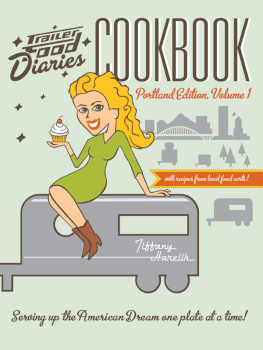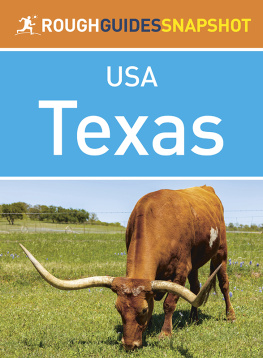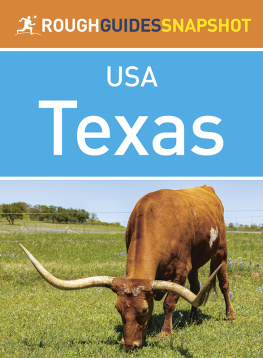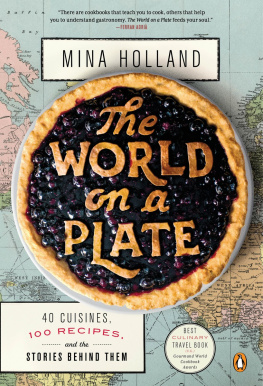
Published by American Palate
A Division of The History Press
Charleston, SC 29403
www.historypress.net
Copyright 2014 by Tiffany Harelik
All rights reserved
Front cover, top: Lesley Brown; bottom left: Lesley Brown; bottom right: Cochineal. Unless otherwise noted, all images are by the author.
First published 2014
e-book edition 2014
ISBN 978.1.62585.257.1
Library of Congress Control Number: 2014952375
print edition ISBN 978.1.62619.722.0
Notice: The information in this book is true and complete to the best of our knowledge. It is offered without guarantee on the part of the author or The History Press. The author and The History Press disclaim all liability in connection with the use of this book.
All rights reserved. No part of this book may be reproduced or transmitted in any form whatsoever without prior written permission from the publisher except in the case of brief quotations embodied in critical articles and reviews.
This book is dedicated to the resilient people of the Big Bend.
May this work honor your communities and reflect their true beauty.
CONTENTS
FOREWORD
I am so proud to see where the Trans-Pecos food movement has come from and where it is going. If you had told me there would be a food or a culinary movement back in the early 90s out in Far West Texas, I would have thought you were crazy. In the early 90s, it was sheer survival just trying to run a restaurant in the Big Bend area. It wasnt like you could go right down to the local market and get whatever supplies you needed or hire the best cooks you could find; they were nonexistent. People didnt come out to this area back then to further their cooking careers; they either came to be cowboys or were running from the law. Ill never forget that feeling or what I saw as long as I live! I was on a train heading west from Houston to Alpine, Texas, in 1991 on my way to the Gage Hotel. It was about eight oclock in the morning, and I had just woken up from a restless night cramped against a train window. I looked out and could not believe what I sawthe desert and the mountains and just the sheer vastness of where I was was life changing! I had no idea how really life changing it would be until about ten years later. After a week in Marathon, I took on the task of running the restaurant at the Gage Hotel.
I arrived in Marathon around March 1991 and began my cooking career there out of sheer mishap. I had come to the Gage to be a restaurant manager, but the chef and the dishwasher both walked out on me one night with close to one hundred people waiting to eat, so I was forced to step behind the stove and figure it out. Up to that point, I could barely boil water, so this was a huge task in a new, desolate environment. I learned to be self-sustainable and to rely on local products far before it was a trendy thing to do. I utilized the local cowboys and chuck wagon cooks to help me cook meats and breads; I even had a local Marathon resident who grew all my vegetables and made my goat cheese. It was at this point I learned to respect food and the process that goes into creating it. After settling into my new role, I was starting to see just how much this vast beautiful place had to offer. It was people like Shirley Rooney, Guy Lee, Biddy Martin and Tom Glasscock who I really owe for showing me all they knew about this West Texas style of cooking.
After spending five years at the Gage, I went on to open the first Reata restaurant in Alpine, Texas. Sticking with what I knew by drawing off the influences of the border and crossing that with ranch-style comfort food was natural. With the national attention from people like Martha Stewart and Rosie ODonnell, the Reata had become a pretty well-known name in Texas. I also published my first cookbook, A Cowboy in the Kitchen, which was based on cooking from the Trans-Pecos region, about this time. One of my favorite food memories was hosting a Texas-sized barbecue with Martha Stewart at the Chianti Foundation. It was four days of mariachis, margaritas and barbecue. It was during this time I also learned to love the vastness and purity of the Trans-Pecos. As harsh as it could be on some people, it turned out to be an oasis for me.
Flash-forward to today, and seeing the forward thinking and movement on the food front is not only exciting but infectious. From Marathon down to the border over to Marfa and Valentine and then up to Fort Davis, you dont have to look hard to see what Im talking about. The region now has its own namesake music festival and food festival, an incredible feat for this part of the state. I also believe the future looks bright for this area. As the art movement keeps growing and as people continue to come visit and live in this area, food will always have its place. My partner at Reata used to call this area a gastronomic wasteland in the 90snot anymore! As you will come to see in the following pages, there is much to celebrate out in West Texas, from the people and their culture to the food and the land!
Grady Spears
Frito Pie with Venison Chili, Fancy Cheeses and Texas Pico
Courtesy of Grady Spears
This is one of our all-time favorite Texan treats. Weve dressed up this version with venison or quail chili, but you can use beef too. The caciotta (or Monterey jack) and goat cheeses add sophistication to the flavor, and the Texas Pico makes a colorful finish with the rich topping of crme frache.
From The Texas Cowboy Kitchen by Grady Spears with June Naylor (Andrews McMeel Publishing)
Makes 68 servings
Venison or Quail Chili:
4 tablespoons vegetable oil
1 red onion, chopped
1 tablespoon minced garlic
2 pounds coarsely ground venison
or diced boneless quail meat
1 cup Red Chile Sauce
1 tablespoon pure chili powder (ancho or New Mexico is good)
2 teaspoons dried oregano
2 teaspoons ground cumin
2 tomatoes, coarsely chopped
3 cups chicken stock
kosher salt
To Assemble:
1 large (16-ounce) bag Fritos
Texas Pico (see page 13)
2 cups shredded caciotta or
Monterey jack cheese
1 cup crumbled goat cheese
2 cups crme frache or sour cream
Prepare the chili by heating the oil in a stew pot or Dutch oven over medium heat. Add the onion and garlic and saut until soft. Add the venison and cook until starting to brown, stirring as necessary. Add the Red Chile Sauce, chili powder, oregano, cumin and tomatoes. Stir well to combine. Cook for 5 minutes; then lower the heat to a simmer and add the stock. Simmer the chili, uncovered, for 45 minutes to 1 hour. Stir occasionally to prevent sticking. Season with salt to taste. Remove from heat and set aside until ready to assemble the Frito pie. If preparing ahead of time, place chili in an airtight container and refrigerate until ready to use.
Assemble Frito pies by piling the Fritos into serving bowls. Top with hot chili, pico and cheeses. Drizzle with crme frache.
Red Chile Sauce (makes 4 cups):
When you let your imagination fly, youll find that Red Chile Sauce can be as versatile as tomato sauce. We use it in tamale fillings, venison chili and enchilada sauces, but youll find your own ways to incorporate it into recipes for meatloaf and hearty casseroles.
16 dried ancho chili peppers, about pound
6 cups water
 cup white wine
cup white wine
white onion, peeled and diced
5 cloves garlic, minced
5 teaspoons packed light brown sugar
2 tablespoons ground cumin
Next page













 cup white wine
cup white wine